TLDR
- Krispy Kreme stock jumped 14% on October 21, closing around $3.71, but remains down 65% year-to-date after falling from over $12 in late 2024.
- The company ended its unprofitable McDonald’s USA partnership in July 2025, which caused a 21% revenue drop in the U.S. segment as it exited 2,400 locations.
- Q2 2025 showed revenue fell 13.5% to $379.8 million with a $441.1 million GAAP loss, largely from $406.9 million in impairment charges.
- Management launched a four-part turnaround plan focused on refranchising international markets, cutting costs, and targeting high-volume U.S. channels.
- The company opened its first Spain location on October 2 and plans expansion in Brazil and Uzbekistan, with over 50 Spanish stores planned in four years.
Krispy Kreme shares jumped roughly 14% on October 21, closing around $3.71. The pop comes after months of declines that saw the stock drop 65% year-to-date.
The recent rally follows news of the company’s international expansion efforts. But the celebrations might be premature.
The doughnut chain faces serious headwinds at home. Q2 2025 results showed revenue fell 13.5% year-over-year to $379.8 million.
The company posted a massive GAAP net loss of $441.1 million. Most of that came from $406.9 million in impairment charges.
U.S. sales took the biggest hit. Revenue in the domestic segment dropped 21% compared to last year.
The McDonald’s partnership collapse explains much of the pain. Krispy Kreme and McDonald’s USA ended their doughnut deal on July 2, 2025.
CEO Josh Charlesworth said the McDonald’s outlets proved unprofitable. The company exited roughly 2,400 locations.
The international picture looks brighter. Sales outside the U.S. grew about 6% from last year.
Canada, Japan, and Mexico showed strength. That’s where management is placing its bets now.
Turnaround Strategy Takes Shape
Management rolled out a four-part plan on August 7, 2025. The strategy aims to fix the balance sheet and restart growth.
First, the company will refranchise owned markets and restructure joint ventures. Second, it plans to improve returns by using existing assets better.
Third, Krispy Kreme will cut costs by outsourcing U.S. logistics. Fourth, it will focus U.S. growth on high-volume, high-margin channels.
Charlesworth told investors the company expects to start recovering profitability in Q3. He emphasized a two-pronged approach.
The plan calls for “profitable U.S. expansion and capital-light international franchise growth.” That’s corporate speak for doing more with less money.
The company also shuffled its leadership team. Raphael Duvivier became CFO in July after serving as President of International.
Longtime growth executive David Skena departed. Alison Holder moved into an expanded brand role.
The changes reflect a renewed focus on marketing and product innovation. Management clearly thinks fresh faces might help.
Global Push Accelerates
Krispy Kreme opened its first Spanish shop in Madrid on October 2. Local franchisee Glaseados Originales partnered on the launch.
Two more Madrid locations are planned by year-end. The company targets over 50 Spanish stores in the next four years.
Charlesworth said the Madrid launch “strengthens our international presence.” The franchise model requires less capital investment.
Brazil is also getting attention. Two new São Paulo outlets are coming via a joint venture.
Uzbekistan represents totally new territory. The first shop in Tashkent is set for October 2025.
The company now operates in over 40 countries. These moves aim to tap emerging demand for fresh doughnuts.
Charlesworth said: “From Spain to Brazil to Uzbekistan, we love seeing the excitement from fans around the world as they enjoy our fresh, delicious treats.”
Morgan Stanley called out Krispy Kreme as the top-performing restaurant stock in Q3. The stock gained 33% during that period.
But the investment firm maintained its ‘Underweight’ rating. Its price target of $2.50 implies a 33% downside from current levels.
The average analyst price target sits around $6.45. That’s well above the current price but far below historic highs.
Zacks recently moved to “strong sell” while JPMorgan stuck with underweight. Most analysts rate the stock around “hold.”
The recent stock jump looks driven by retail momentum rather than fundamentals. Some analysts compared it to 2021’s meme-stock craze.
Capital.com’s Daniela Sabin Hathorn warned: “These surges are often disconnected from company fundamentals and can reverse violently.”






